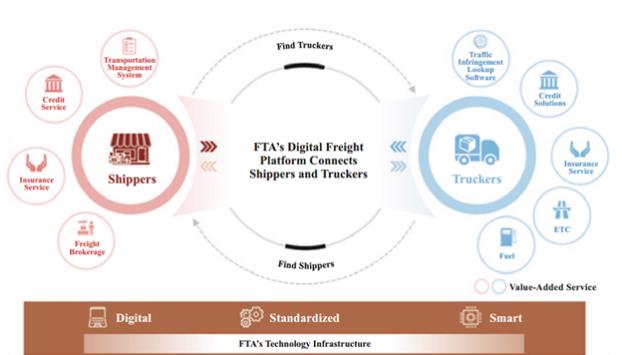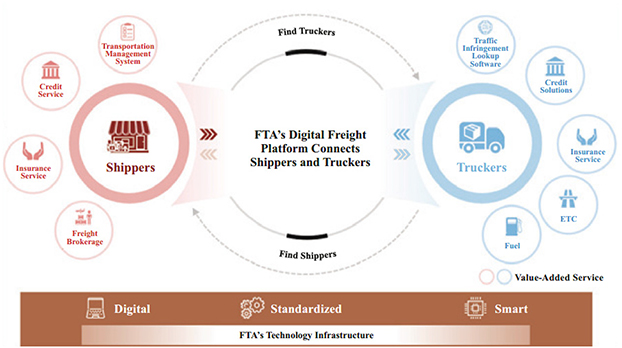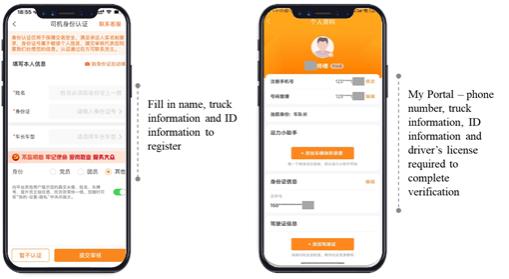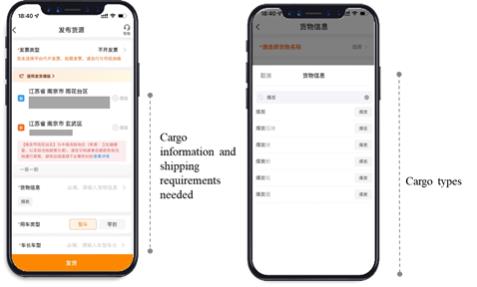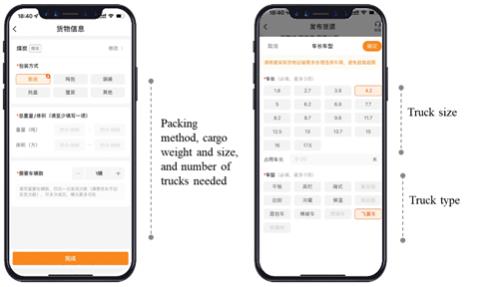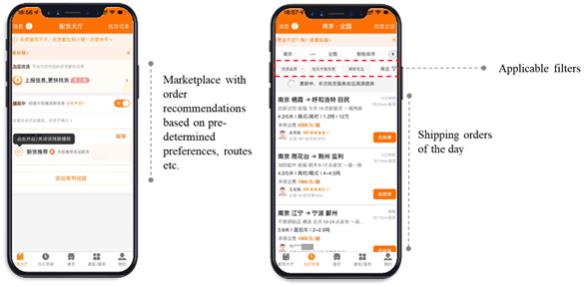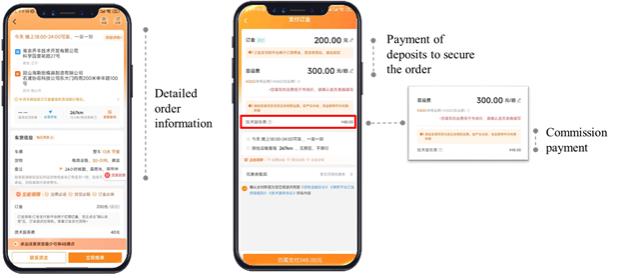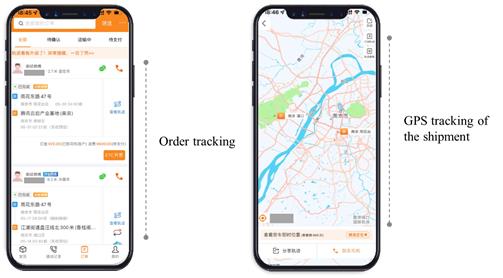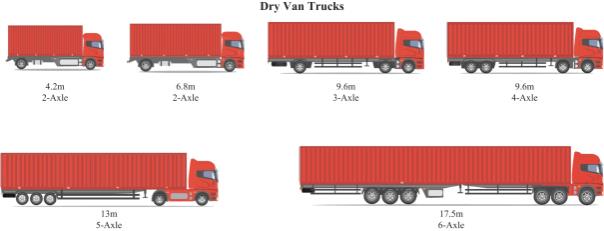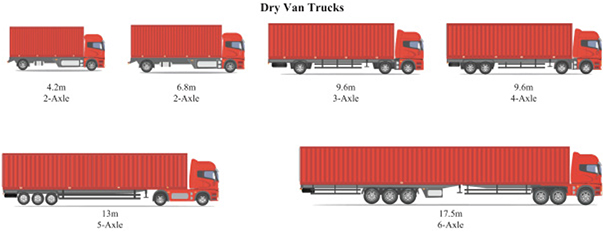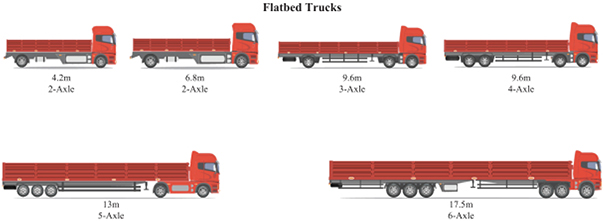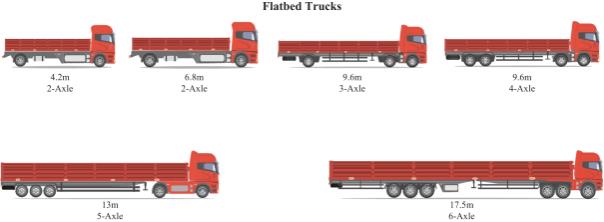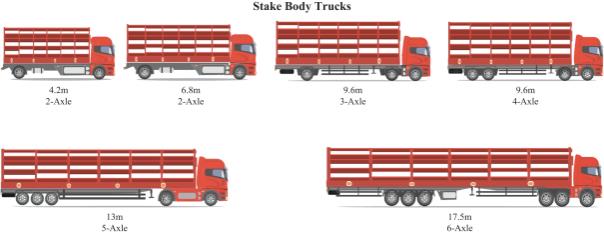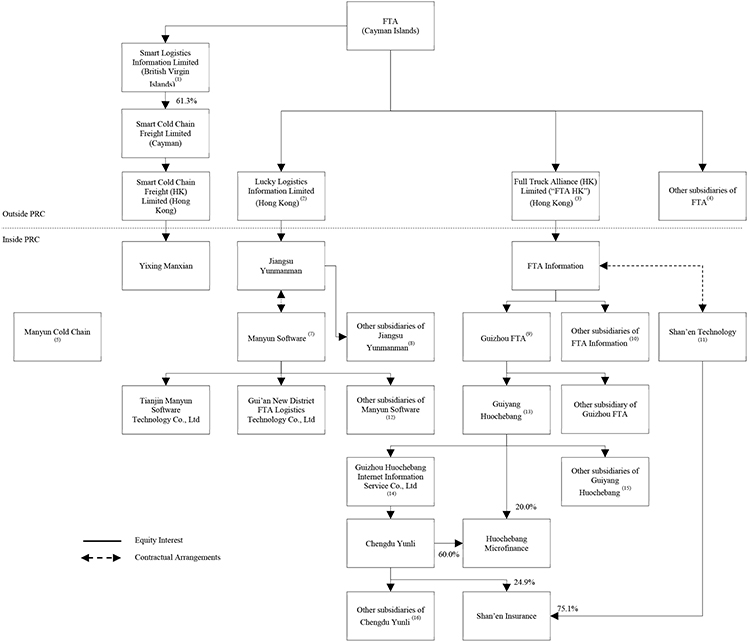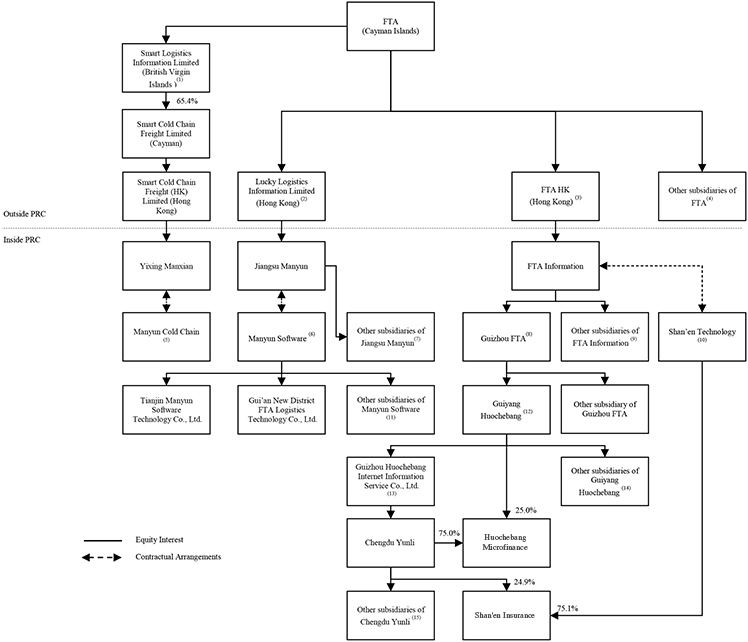| ☐ | REGISTRATION STATEMENT PURSUANT TO SECTION 12(b) OR 12(g) OF THE SECURITIES EXCHANGE ACT OF 1934 |
| ☒ | ANNUAL REPORT PURSUANT TO SECTION 13 OR 15(d) OF THE SECURITIES EXCHANGE ACT OF 1934 |
| ☐ | TRANSITION REPORT PURSUANT TO SECTION 13 OR 15(d) OF THE SECURITIES EXCHANGE ACT OF 1934 |
| ☐ | SHELL COMPANY REPORT PURSUANT TO SECTION 13 OR 15(d) OF THE SECURITIES EXCHANGE ACT OF 1934. |
6 Keji Road Huaxi District, Guiyang Guizhou 550025 People’s Republic of China | Wanbo Science and Technology Park, 20 Fengxin Road Yuhuatai District, Nanjing Jiangsu 210012People’s Republic of China |
Title of each class | Trading Symbol(s) | Name of each exchange on which registered | ||
American Depositary Shares, eachrepresenting | YMM | New York Stock Exchange | ||
Class A ordinary shares, US$0.00001 par value per share* | New York Stock Exchange | |||
| * | Not for trading, but only in connection with the registration of American Depositary Shares representing such Class A ordinary shares pursuant to the requirements of the Securities and Exchange Commission. |
Title of class | Number of shares outstanding | |
Class A ordinary shares were outstanding as of December 31, | ||
Class B ordinary shares were outstanding as of December 31, |
| Large accelerated filer | ☒ | Accelerated filer | ☐ | Non-accelerated filer | ☐ | |||||
| Emerging growth company | ☐ | |||||||||
| † | The term “new or revised financial accounting standard” refers to any update issued by the Financial Accounting Standards Board to its Accounting Standards Codification after April 5, 2012. |
| U.S. GAAP ☒ | International Financial Reporting Standards as issued | Other ☐ | ||||||
| by the International Accounting Standards Board | ☐ |
TABLE OF CONTENTS
| PART I | 3 | ||||||
ITEM 1. IDENTITY OF DIRECTORS, SENIOR MANAGEMENT AND ADVISERS | 3 | ||||||
| 3 | |||||||
| 3 | |||||||
| 124 | |||||||
| 124 | |||||||
| 159 | |||||||
ITEM 11. QUANTITATIVE AND QUALITATIVE DISCLOSURES ABOUT MARKET RISK | 172 | ||||||
ITEM 12. DESCRIPTION OF SECURITIES OTHER THAN EQUITY SECURITIES | 173 | ||||||
| PART II | 175 | ||||||
| 175 | |||||||
ITEM 14. MATERIAL MODIFICATIONS TO THE RIGHTS OF SECURITY HOLDERS AND USE OF PROCEEDS | 175 | ||||||
| 175 | |||||||
ITEM 16D. EXEMPTIONS FROM THE LISTING STANDARDS FOR AUDIT COMMITTEES | |||||||
ITEM 16E. PURCHASE OF EQUITY SECURITIES BY THE ISSUER AND AFFILIATED PURCHASERS | |||||||
| 179 | |||||||
| 179 | |||||||
| 179 | |||||||
ITEM 16I. DISCLOSURE REGARDING FOREIGN JURISDICTIONS THAT PREVENT INSPECTIONS | 179 | ||||||
| 179 | |||||||
| 180 | |||||||
| PART III | |||||||
i
Conventions That Apply to This Annual Report on Form 20-F
Unless we indicate otherwise, references in this annual report on Form 20-F to:
“active shippers” are to the aggregate number of registered shipper accounts on the FTA platform that have posted at least one shipping order on the FTA platform during a given period; some shippers may use more than one account, and/or may share the same account with other shippers;
“ADSs” are to American depositary shares, each of which represents 20 Class A ordinary shares in our Company;
“China” and the “PRC” are to the People’s Republic of China, excluding, for the purposes of this annual report only, Taiwan, the Hong Kong Special Administrative Region and the Macao Special Administrative Region;
“commissioned GTV” are to the amount of GTV relating to shipping orders that were subject to commissions for online transaction service in a given period;
“consolidated affiliates” are to the Group VIEs and their respective subsidiaries;
| • | “FTA platform” are to a digital, standardized and smart freight platform that connects shippers and truckers, currently providing services under the brands of Yunmanman, Huochebang, Shengsheng and |
“fulfilled orders” are to all shipping orders matched through the FTA platform during a given period but exclude (i) shipping orders that are subsequently canceled, and (ii) shipping orders for which platform users failed to specify any freight prices as there are substantial uncertainties as to whether the shipping orders are fulfilled;
“Group” are to Full Truck Alliance Co. Ltd., the Group VIEs and their respective subsidiaries;
“Group VIEs” are to the variable interest entities, or VIEs, that are 100% owned by PRC citizens and hold certain business operation licenses or approvals, and generally operate businesses in which foreign investment is restricted, and are consolidated into the Group’s consolidated financial statements in accordance with U.S. GAAP;
“GTV” or “gross transaction value” are to the aggregate freight prices specified by platform users for all fulfilled orders on the FTA platform during the period without deducting any commission or service fee charged by us; we make downward adjustments to unreasonably high freight prices specified by users that are apparently due to clerical errors;
“Hong Kong dollar(s)” or “HK dollar(s)” or “HK$” or “HKD” are to Hong Kong dollars, the lawful currency of Hong Kong;
| • | “Huochebang” are to the brand of Huochebang or the Huochebang platform, which was a leading digital freight platform providing services under the brand of Huochebang and integrated into the FTA platform following the establishment of our Company, as the context requires; |
“ordinary shares” are to Class A ordinary shares, US$0.00001 par value per share in our Company, and Class B ordinary shares, US$0.00001 par value per share in our Company; each Class A ordinary share is entitled to one vote; each Class B ordinary share is entitled to 30 votes;
“Plus” are to PlusAI Corp, a company organized under the laws of the Cayman Islands, and its affiliates;
“RMB” or “Renminbi” are to the legal currency of China;
1
“road transportation industry” or “road transportation market” are to the market of transportation services for raw material, semi-finished goods and finished goods by trucks on roads;
1
“shipper MAUs” are to the number of active shippers in a given month; “average shipper MAUs” in a given period are calculated by dividing (i) the sum of shipper MAUs for each month of such period, by (ii) the number of months in such period;
“US$,” “U.S. dollars,” or “dollars” are to the legal currency of the United States;
“we,” “us,” “our Company,” “our,” or “FTA” are to Full Truck Alliance Co. Ltd. and/or its subsidiaries, as the context requires; and
| • | “Yunmanman” are to the brand of Yunmanman or the Yunmanman platform, which was a leading digital freight platform providing services under the brand of Yunmanman and integrated into the FTA platform following the establishment of our Company, as the context requires. |
This annual report contains translations between Renminbi and U.S. dollars for the convenience of the reader. The translations from Renminbi to U.S. dollars and from U.S. dollars to Renminbi in this annual report were made at a rate of RMB6.8972RMB7.0999 to US$1.00, the exchange rate set forth in the H.10 statistical release of the Federal Reserve Board on December 30, 2022.29, 2023. We make no representation that the Renminbi or U.S. dollar amounts referred to in this annual report could have been or could be converted into U.S. dollars or Renminbi, as the case may be, at any particular rate or at all.
This annual report includes our audited consolidated financial statements for the years ended December 31, 2020, 2021, 2022 and 2022.2023.
Our ADSs are listed on the New York Stock Exchange under the ticker symbol “YMM.”
FORWARD-LOOKING INFORMATION
This annual report on Form 20-F contains forward-looking statements that reflect our current expectations and views of future events. These statements are made under the “safe harbor” provisions of the U.S. Private Securities Litigation Reform Act of 1995. You can identify these forward-looking statements by terminology such as “may,” “will,” “expect,” “anticipate,” “future,” “intend,” “plan,” “believe,” “estimate,” “is/are likely to” or other similar expressions. We have based these forward-looking statements largely on our current expectations and projections about future events and financial trends that we believe may affect the Group’s financial condition, results of operations, business strategy and financial needs. These forward-looking statements include, but are not limited to:
our goal and strategies;
our expansion plans;
our future business development, financial condition and results of operations;
expected changes in the Group’s revenues, costs or expenses;
industry landscape of, and trends in, China’s road transportation market;
competition in our industry;
our expectations regarding demand for, and market acceptance of, the Group’s services;
our expectations regarding the Group’s relationships with shippers, truckers and other ecosystem participants;
our ability to protect our systems and infrastructures from cyber-attacks;
2
PRC laws, regulations, and policies relating to the road transportation market;
the impact of any regulatory action taken against us;
2
| • | the impact of COVID-19 pandemic, extreme weather conditions and production constraints brought by electricity rationing measures; and |
general economic and business conditions.
We would like to caution you not to place undue reliance on these forward-looking statements and you should read these statements in conjunction with the risk factors disclosed in “Item 3.D. Key Information—Risk Factors.” Those risks are not exhaustive. We operate in a rapidly evolving environment. New risks emerge from time to time and it is impossible for our management to predict all risk factors, nor can we assess the impact of all factors on the Group’s business or the extent to which any factor, or combination of factors, may cause actual results to differ from those contained in any forward-looking statement. We do not undertake any obligation to update or revise the forward-looking statements except as required under applicable law.
PART I
| ITEM 1. | IDENTITY OF DIRECTORS, SENIOR MANAGEMENT AND ADVISERS |
Not required.
| ITEM 2. | OFFER STATISTICS AND EXPECTED TIMETABLE |
Not required.
| ITEM 3. | KEY INFORMATION |
Our Corporate Structure
Full Truck Alliance Co. Ltd. is not a Chinese operating company but a Cayman Islands holding company with operations primarily conducted (i) through contractual arrangements with certain variable interest entities, or the Group VIEs, in China and (ii) by our subsidiaries in China. Under the PRC laws and regulations, the provision of value-added telecommunication services and certain financial services in the PRC is subject to foreign investment restrictions and license requirements. Therefore, we operate such business in China through the Group VIEs, and rely on contractual arrangements among our PRC subsidiaries, the Group VIEs and their respective individual shareholders to control the business operations of the Group VIEs. Investors in our ADSs do not hold equity interest in the Group’s operating entities in China, but instead hold an equity interest in Full Truck Alliance Co. Ltd., a Cayman Islands holding company. As used in this annual report, “FTA,” “we,” “us,” “our Company” or “our” refers to Full Truck Alliance Co. Ltd. and/or its subsidiaries, “the Group” refers to Full Truck Alliance Co. Ltd., the Group VIEs and their respective subsidiaries, and “the consolidated affiliates” refers to the Group VIEs and their respective subsidiaries.
Prior to the fourth quarter of 2021, our Group VIEs were Shanghai Xiwei Information Consulting Co., Ltd., or Shanghai Xiwei, Beijing Manxin Technology Co., Ltd, or Beijing Manxin (formerly known as Beijing Yunmanman Technology Co., Ltd., or Beijing Yunmanman), and Guizhou FTA Logistics Technology Co., Ltd., or Guizhou FTA. In the fourth quarter of 2021, in order to enhance corporate governance, we underwent a reorganization of the holding structure of our onshore subsidiaries and the consolidated affiliates, or the Reorganization. The Reorganization mainly involved (i) changing the Group VIEs and (ii) changing certain subsidiaries of the Group VIEs to wholly-owned or partly-owned subsidiaries of our Company, to the extent permitted under the relevant PRC laws and regulations. The Reorganization was completed on January 1, 2022. InOn May 24, 2022, Nanjing Manyun Cold Chain Technology Co., Ltd., or Manyun Cold Chain, which was a majority-owned subsidiary of Jiangsu Manyun Software Technology Co., Ltd., or Manyun Software, was transferred to nominee shareholders. Yixing Manxian Information Technology Co., Ltd., or Yixing Manxian, our PRC subsidiary, gained control over Nanjing Manyun Cold Chain Technology Co., Ltd., or Manyun Cold Chain, a majority-owned subsidiary of Jiangsu Manyun Software Technology Co., Ltd., or Manyun Software, through a series of contractual arrangements with Manyun Cold Chain and its shareholders. Currently, the Group VIEs are (i) Manyun Software, (ii) Guiyang Shan’en Technology Co., Ltd., or Shan’en Technology, and (iii) Manyun Cold Chain.
3
The following diagram illustrates our corporate structure with our principal subsidiaries as of December 31, 2022.2023. Certain entities that are immaterial to our results of operations, business and financial condition are omitted. Except as otherwise specified, equity interests depicted in this diagram are held as to 100%.
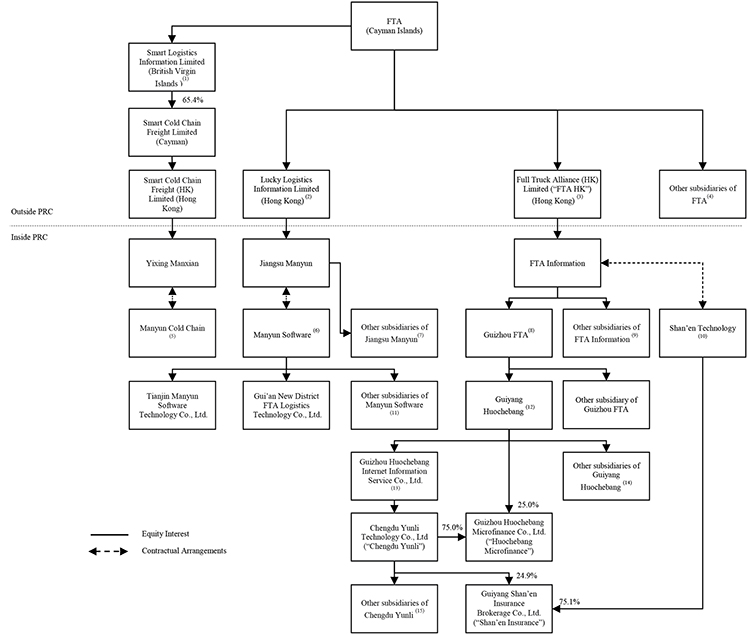

| (1) | Smart Logistics Information Limited also wholly owns one insignificant subsidiary. |
| (2) | Besides Jiangsu Yunmanman Information Technology Co., Ltd. (formerly known as Jiangsu Manyun Logistics Information Co., Ltd.), or Jiangsu |
| (3) | Besides Full Truck Alliance Information Technology Co., Ltd. (formerly known as Full Truck Alliance Information Consulting Co., Ltd.), or FTA Information, FTA HK’s subsidiaries include two insignificant subsidiaries incorporated in the PRC that are wholly-owned by FTA HK and one insignificant subsidiary incorporated in the British Virgin Islands that is wholly-owned by FTA HK. |
| (4) | Include two insignificant subsidiaries that are wholly-owned by FTA. |
4
| (5) | Manyun Software, Tianjin Zhihui Yunli Management Consulting Partnership (Limited Partners), or Tianjin Zhihui, Mr. Peter Hui Zhang and Mr. Wenjian Dai hold 77.5%, 10.0%, 7.5% and 5.0% of equity interest in Manyun Cold Chain, respectively. Manyun Cold Chain primarily provides freight matching services for the cold chain logistics sector and operates Yunmanman Cold Chain apps. |
| (6) | Jiangsu Yunmanman and another subsidiary of Lucky Logistics Information Limited each holds 50.0% of the equity interest in Jiangsu Manyun Technology Industry Co., Ltd, or Manyun Technology. |
| (7) | Mr. Peter Hui Zhang and Ms. Guizhen Ma hold 70% and 30% equity interest, respectively, in Manyun Software. Manyun Software and its subsidiaries are primarily involved in operating the Yunmanman apps and Shengsheng apps and providing freight matching services. |
Include eight insignificant subsidiaries that are wholly-owned by Jiangsu |
In March 2021, Guizhou FTA became a Group VIE. On January 1, 2022, FTA Information acquired Guizhou FTA from its shareholders and it became a wholly-owned subsidiary of FTA Information. |
Include two insignificant subsidiaries that are wholly owned by FTA Information. |
Mr. Peter Hui Zhang and Ms. Guizhen Ma hold 70% and 30% equity interest, respectively, in Shan’en Technology. Shan’en Technology and its subsidiaries are primarily involved in operating the Huochebang apps and providing freight matching services and insurance brokerage services. |
Include |
Previously, Guiyang Huochebang Technology Co., Ltd., or Guiyang Huochebang, was a Group VIE. In March 2021, as directed by FTA Information, Guizhou FTA, a newly established entity, acquired 100% of equity interest in Guiyang Huochebang for a nominal price from the shareholders of Guiyang Huochebang, and FTA Information gained control over Guizhou FTA through a series of contractual arrangements with Guizhou FTA and its shareholders. As a result, Guizhou FTA became a Group VIE, and Guiyang Huochebang became a subsidiary of Guizhou FTA. |
Guiyang Huochebang and FTA Information hold 83.8% and 16.2% of equity interest in Guizhou Huochebang Internet Information Service Co., Ltd., respectively. |
Include |
Include two insignificant subsidiaries that are wholly-owned by Chengdu Yunli. |
The contractual arrangements among our PRC subsidiaries, the Group VIEs and their respective individual shareholders collectively enable us to:
exercise effective control over our Group VIEs and their subsidiaries;
receive substantially all the economic benefits of our Group VIEs; and
have an exclusive option to purchase all or part of the equity interests in all or part of the assets when and to the extent permitted by PRC law.
These contractual arrangements generally include equity interest pledge agreements, spousal consent letters, power of attorney, loan agreements, exclusive service agreement and exclusive option agreement, as the case may be. As a result of the contractual arrangements, we are considered the primary beneficiary of these companies for accounting purposes, and we have consolidated the financial results of these companies in the Group’s consolidated financial statements. However, we do not own equity interest in the Group VIEs. Furthermore, Full Truck Alliance Co. Ltd., as our holding company, does not conduct operating activities other than holding investment in certain of our equity investees.
The individual nominee shareholders of the Group VIEs are current or former directors and/or members of senior management of our Company. We consider such individuals suitable to act as the nominee shareholders of the Group VIEs because of, among other considerations, their contribution to the Group, their competence and their length of service with and loyalty to the Group. For more details of these contractual arrangements, see “Item 4. Information on the Company—C. Organizational Structure—Contractual Arrangements with the Group VIEs.”
We are subject to risks associated with our contractual arrangements with the Group VIEs. Our Company and its investors may never have a direct ownership interest in the businesses that are conducted by the Group VIEs. The contractual arrangements may not be as effective as direct ownership in providing us with control over the Group VIEs. If the Group VIEs or their shareholders fail to perform their respective obligations under these contractual arrangements, we could be limited in our ability to enforce these contractual arrangements. There are very few precedents and little formal guidance as to how contractual arrangements in the context of a variable interest entity should be interpreted or enforced under PRC law. If we are unable to maintain effective control, we would not be able to continue to consolidate the financial results of these entities in the Group’s financial statements. See “—D. Risk Factors—Risks Relating to Our Corporate Structure—We rely on contractual arrangements with the Group VIEs and their shareholders to conduct a substantial part of the Group’s operations in China, which may not be as effective as direct ownership in providing operational control and otherwise have a material adverse effect as to our business” and “—D. Risk Factors—Risks Relating to Our Corporate Structure—The shareholders of the Group VIEs may have potential conflicts of interest with us, which may materially and adversely affect our business and financial condition.”
5
There are also substantial uncertainties regarding the interpretation and application of current and future PRC laws, regulations and rules regarding the status of the rights of our Cayman Islands holding company with respect to its contractual arrangements with the Group VIEs and their nominee shareholders. It is uncertain whether any new PRC laws or regulations relating to variable interest entity structures will be adopted or if adopted, what they would provide. If we or any of the Group VIEs is found to be in violation of any existing or future PRC laws or regulations, or fail to obtain or maintain any of the required permits or approvals, the relevant PRC regulatory authorities would have broad discretion in accordance with the applicable laws and regulations to take action in dealing with such violations or failures. The majority of the Group’s assets, along with severalGroup VIEs hold certain material licenses and assets to conduct business in China are held by the Group VIEs. In addition,and contribute the majority of the Group’s revenues are generated by the Group VIEs.revenues. An event that results in the deconsolidation of the Group VIEs would have a material effect on the Group’s operations and cause the value of the securities of our Company to diminish substantially or even become worthless. See “—D. Risk Factors—Risks Relating to Our Corporate Structure— If the PRC government deems that the contractual arrangements in relation to the Group VIEs do not comply with PRC regulatory restrictions on foreign investment in the relevant industries, or if these regulations or the interpretation of existing regulations change in the future, we could be subject to severe penalties or be forced to relinquish our interests in those operations.”
The Group also faces various legal and operational risks and uncertainties associated with being based in or having its operations primarily in China and the country’s complex and evolving laws and regulations. For example, the Group faces risks associated with regulatory approvals on offerings conducted overseas by and foreign investment in China-based issuers, the use of the Group VIEs, anti-monopoly regulatory actions, and oversight on cybersecurity and data privacy, which may impact the Group’s ability to conduct certain businesses, accept foreign investments, or list on a U.S. or other foreign exchange outside of China. These risks could result in a material adverse change in the Group’s operations and the value of our ADSs, significantly limit or completely hinder our ability to offer or continue to offer securities to investors, or cause the value of such securities to significantly decline. See “—D. Risks Factors— Risks Relating to Doing Business in China.”
Holding Foreign Companies Accountable Act
The Holding Foreign Companies Accountable Act, as amended, or the HFCA Act, was signed into law on December 18, 2020 and amended pursuant to the Consolidated Appropriations Act, 2023 on December 29, 2022. Under the HFCA Act and the rules issued by the SEC and the PCAOB thereunder, if we have retained a registered public accounting firm to issue an audit report where the registered public accounting firm has a branch or office that is located in a foreign jurisdiction and the PCAOB has determined that it is unable to inspect or investigate completely because of a position taken by an authority in the foreign jurisdiction, the SEC will identify us as a “covered issuer”, or SEC-identified issuer, shortly after we file with the SEC a report required under the Securities Exchange Act of 1934, or the Exchange Act (such as our annual report on Form 20-F), that includes an audit report issued by such accounting firm; and if we were to be identified as an SEC-identified issuer for two consecutive years, the SEC would prohibit our securities (including our shares or ADSs) from being traded on a national securities exchange or in the over-the-counter trading market in the United States.
In December 2021, the PCAOB made its determinations, or the 2021 determinations, pursuant to the HFCA Act that it was unable to inspect or investigate completely registered public accounting firms headquartered in mainland China or Hong Kong, including our auditor, Deloitte Touche Tohmatsu Certified Public Accountants LLP. After we filed our annual report on Form 20-F for the fiscal year ended December 31, 2021 that included an audit report issued by Deloitte Touche Tohmatsu Certified Public Accountants LLP on April 25, 2022, the SEC conclusively identified us as an SEC-identified issuer on May 26, 2022.
Following the Statement of Protocol signed between the PCAOB and the China Securities Regulatory Commission and the Ministry of Finance of the PRC in August 2022 and the on-site inspections and investigations conducted by the PCAOB staff in Hong Kong from September to November 2022, the PCAOB Board voted in December 2022 to vacate the previous 2021 determinations, and as a result, our auditor, Deloitte Touche Tohmatsu Certified Public Accountants LLP, iswas no longer a registered public accounting firm that the PCAOB iswas unable to inspect or investigate completely as of the date of thisour annual report for the fiscal year ended December 31, 2022, or at the time of issuance of2022 annual report, and we were not identified as an SEC-identified issuer after we filed the audit2022 annual report included herein.in 2023. On November 30, 2023, the PCAOB announced that it had completed its inspections on registered public accounting firms headquartered in mainland China and Hong Kong for 2023 with the complete access required under the HFCA Act. As such, we do not expect to be identified as an SEC-identified issuer again in 2023.2024 either. However, the PCAOB may change its determinations under the HFCA Act at any point in the future. See “—D. Risks Factors— Risks Relating to Doing Business in China—If the PCAOB determines that it is unable to inspect or investigate completely our auditor at any point in the future, our ADSs may be prohibited from trading in the United States under the Holding Foreign Companies Accountable Act, as amended, or the HFCA Act, and any such trading prohibition on our ADSs or threat thereof may materially and adversely affect the price of our ADSs and value of your investment.”
6
Licenses, Permits and Approvals
We conduct our business primarily through (i) our Group VIEs and their subsidiaries in China and (ii) our subsidiaries in China. Our operations in China are governed by PRC laws and regulations. The Group has received all material permissions that are, or may be, required for its operations in China, including the operations of the Group VIEs. See “Item 4. Information on the Company—B. Business Overview— Licenses, Permits and Approvals.” for more details.
No material permission has been denied from us by relevant authorities in China. To enhance the experience of shippers, truckers and other ecosystem participants, we offer various auxiliary functions, content and value-added services through the FTA platform. Given the uncertainties of interpretation and implementation of relevant laws and regulations and the enforcement practices by relevant government authorities, we may be required to obtain additional licenses, permits, filings or approvals for these functions, content and services. See “—D. Risk Factors—Risks Relating to Our Business and Industry— If we fail to obtain or maintain licenses, permits or approvals applicable to the Group’s business, we may become subject to significant penalties and other regulatory proceedings or actions.”
In connection with our previous issuance of securities to foreign investors, under current PRC laws, regulations and regulatory rules, as of the date of this annual report, we, our PRC subsidiaries and our Group VIEs, (i) are not required to obtain permissions from the CSRC, (ii) are not required to go through cybersecurity review by the Cyberspace Administration of China, or the CAC, and (iii) have not received or were denied such requisite permissions by any PRC authority. However, the PRC government has recently indicated an intent to exert more oversight and control over offerings that are conducted overseas and/or foreign investment in China-based issuers, and we cannot assure you that the relevant PRC government authorities will reach the same conclusion. The Cybersecurity Review Office of the CAC announced the initiation of a cybersecurity review of the Yunmanman apps and Huochebang apps on July 5, 2021. During the cybersecurity review, the Yunmanman and Huochebang apps were required to suspend new user registration. Based on notification by the CRO, we have resumed new user registration on the Yunmanman and Huochebang apps since June 29, 2022. For more details, see “—D. Risk Factors—Risks Relating to Our Business and Industry— The Group’s business is subject to complex and evolving PRC laws and regulations relating to cybersecurity and data security” and —D. Risk Factors—Risks Relating to Our Corporate Structure—Uncertainties exist with respect to the interpretation and implementation of the newly enacted PRC Foreign Investment Law and its implementing rules and how they may impact the Group’s business, financial condition and results of operations.”
Cash Transfers within Our Corporate Structure
Full Truck Alliance Co. Ltd. is a Cayman Islands holding company with operations primarily conducted (i) through the consolidated affiliates in China and (ii) by our subsidiaries in China. Full Truck Alliance Co. Ltd.’s ability to pay dividends depends upon dividends paid by our PRC subsidiaries.
7
In 2020, 2021 and 2022, no assets other than cash were transferred within our organization. The following diagram summarizes how funds arecash was transferred among our Company, our subsidiaries and the consolidated affiliates.affiliates in 2021, 2022 and 2023.
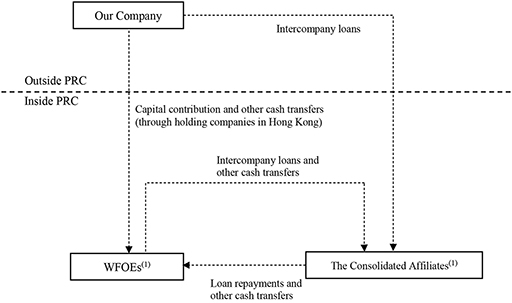
| (1) | Our PRC subsidiaries, Jiangsu |
The following table sets forth a summary of the cash flows that occurred between our Company, our subsidiaries, and the consolidated affiliates.
| For the Years Ended December 31, | For the Years Ended December 31, | |||||||||||||||||||||||||||||||
| 2020 | 2021 | 2022 | 2021 | 2022 | 2023 | |||||||||||||||||||||||||||
| RMB | RMB | RMB | US$ | RMB | RMB | RMB | US$ | |||||||||||||||||||||||||
| (in thousands) | (in thousands) | |||||||||||||||||||||||||||||||
Intercompany Cash Flow Data: | Intercompany Cash Flow Data: |
| Intercompany Cash Flow Data: |
| ||||||||||||||||||||||||||||
Transfer from our Company to our subsidiaries | 724,248 | 2,103,259 | 2,050,687 | 297,322 | 2,103,259 | 2,050,687 | 1,833,910 | 258,301 | ||||||||||||||||||||||||
Transfer from our Company to the consolidated affiliates | — | — | 488,159 | 70,776 | — | 488,159 | — | — | ||||||||||||||||||||||||
Transfer from our subsidiaries to the consolidated affiliates | 1,858,922 | 6,323,470 | 3,075,366 | 445,886 | 6,323,470 | 3,075,366 | 1,952,383 | 274,987 | ||||||||||||||||||||||||
Transfer from the consolidated affiliates to our subsidiaries | 2,031,374 | 4,637,600 | 4,002,115 | 580,252 | 4,637,600 | 4,002,115 | 3,398,082 | 478,610 | ||||||||||||||||||||||||
Our Company made cash transfers to our subsidiaries primarily in the form of capital contribution in 2020, 2021 and 2022.2022 and made other cash transfers to our subsidiaries in 2023.
8
Our Company made cash transfers to the consolidated affiliates in the form of intercompany loans in 2022 to finance the consolidated affiliates’ operations. Our company did not make cash transfers to the consolidated affiliates in 2021 and 2023.
Our subsidiaries made cash transfers to the consolidated affiliates primarily in the form of intercompany loans in 2020, 2021, 2022 and 20222023 to finance the consolidated affiliates’ operations.
The consolidated affiliates made loan repayments and other cash transfers to our subsidiaries primarily in the form of loan repayments in 2020, 2021, 2022 and 2022.2023.
The Group VIEs did not pay any service fee under the exclusive service agreements in 2020, 2021, 2022 and 2022.2023.
Since inception,On March 13, 2024, we have not declared an annual cash dividend for the year ended December 31, 2023 of US$0.0072 per ordinary share, or paid anyUS$0.1444 per ADS, payable on or around April 19, 2024, to holders of record of the Company’s ordinary shares at the close of business on April 5, 2024. The aggregate amount of the dividend was approximately US$150 million. Any other future determination to pay dividends on our shares. We do not have any present plan to declare or pay any dividends on our shares or ADSs inwill be made at the foreseeable future. We intend to retain most, if not all,discretion of our available funds and any future earnings to operate and expand the Group’s business.board of directors.
Restrictions on Transfer of Funds
In 2020, 2021, 2022 and 2022,2023, no dividends or distributions were made to our Company by our subsidiaries. Our ability to pay dividends, if any, to the shareholders and ADSs investors and to service any debt we may incur willmay depend upon dividends paid by our PRC subsidiaries. Under PRC laws and regulations, our PRC subsidiaries are subject to certain restrictions with respect to paying dividends or otherwise transferring any of their net assets offshore to us. In particular, under PRC laws, rules and regulations, each of our subsidiaries incorporated in China is required to set aside at least 10% of its net income each year to fund certain statutory reserves until the cumulative amount of such reserves reaches 50% of its registered capital. These reserves, together with the registered capital, are not distributable as cash dividends.
Furthermore, we are subject to restrictions on currency exchange. The Renminbi is currently convertible under the “current account,” which includes dividends, trade and service-related foreign exchange transactions, but not under the “capital account,” which includes foreign direct investment and loans, including loans we may secure from our PRC subsidiaries. Currently, our PRC subsidiaries may purchase foreign currency for settlement of “current account transactions,” including payment of dividends to us, by complying with certain procedural requirements. However, the relevant PRC governmental authorities may limit or eliminate our ability to purchase foreign currencies in the future for current account transactions. Foreign exchange transactions under the capital account remain subject to limitations and require approvals from, or registration with, the SAFE and other relevant PRC governmental authorities. Since a significant amount of our future revenues and cash flow will be denominated in Renminbi, any existing and future restrictions on currency exchange may limit our ability to utilize cash generated in Renminbi to fund our business activities outside of the PRC or pay dividends in foreign currencies to our shareholders, including holders of our ADSs, and may limit our ability to obtain foreign currency through debt or equity financing for our onshore subsidiaries. If any of our subsidiaries incurs debt on its own behalf in the future, the instruments governing such debt may restrict its ability to pay dividends to us. For certain Cayman Islands, PRC and United States federal income tax considerations of an investment in the ADSs, see “Item 10. Additional Information — E. Taxation.”
Summary Financial Information Related to the Consolidated Affiliates
The following condensed consolidated financial statement information presents information related to Full Truck Alliance Co. Ltd., or the Parent, which is a Cayman holding company, the consolidated affiliates and our subsidiaries as of December 31, 2020, 2021, 2022 and 20222023 and for the years ended 2020, 2021, 2022 and 2022.2023. The consolidated affiliates in the following refer to Shanghai Xiwei, Guizhou FTA and Beijing Manxin and their respective subsidiaries in 2020 and 2021 and refer to Manyun Software, Shan’en Technology and Manyun Cold Chain and their respective subsidiaries in 2022.2022 and 2023. See “Item 4. Information on the Company—C. Organizational Structure.”
9
The following tables presentspresent the condensed consolidated schedule of results of operation data for the periods indicated.
| For the Years Ended December 31, | For the Years Ended December 31, | |||||||||||||||||||||||||||||||||||||||||||||||||||||||||||||||||||||||||||||||
| 2020 | 2021 | 2021 | 2022 | |||||||||||||||||||||||||||||||||||||||||||||||||||||||||||||||||||||||||||||
| Parent | Consolidated affiliates | Subsidiaries | Eliminating Entries | Total | Parent | Consolidated affiliates | Subsidiaries | Eliminating Entries | Total | Parent | Consolidated affiliates | Subsidiaries | Eliminating Entries | Total | Parent | Consolidated affiliates | Subsidiaries | Eliminating Entries | Total | |||||||||||||||||||||||||||||||||||||||||||||||||||||||||||||
| RMB | RMB | RMB | RMB | RMB | RMB | RMB | RMB | RMB | RMB | RMB | RMB | RMB | RMB | RMB | RMB | RMB | RMB | RMB | RMB | |||||||||||||||||||||||||||||||||||||||||||||||||||||||||||||
| (in thousands) | (in thousands) | |||||||||||||||||||||||||||||||||||||||||||||||||||||||||||||||||||||||||||||||
Freight Matching Services | — | 1,947,016 | — | — | 1,947,016 | — | 3,946,882 | — | — | 3,946,882 | — | 3,946,882 | — | — | 3,946,882 | — | 5,549,537 | 107,114 | — | 5,656,651 | ||||||||||||||||||||||||||||||||||||||||||||||||||||||||||||
Freight brokerage | — | 1,365,207 | — | — | 1,365,207 | — | 2,497,779 | — | — | 2,497,779 | — | 2,497,779 | — | — | 2,497,779 | — | 3,360,313 | — | — | 3,360,313 | ||||||||||||||||||||||||||||||||||||||||||||||||||||||||||||
Freight listings | — | 538,665 | — | — | 538,665 | — | 753,031 | — | — | 753,031 | — | 753,031 | — | — | 753,031 | — | 745,266 | 107,114 | — | 852,380 | ||||||||||||||||||||||||||||||||||||||||||||||||||||||||||||
Transaction commission | — | 43,144 | — | — | 43,144 | — | 696,072 | — | — | 696,072 | — | 696,072 | — | — | 696,072 | — | 1,443,958 | — | — | 1,443,958 | ||||||||||||||||||||||||||||||||||||||||||||||||||||||||||||
Value-added services(1) | — | 606,519 | 205,693 | (178,408 | ) | 633,804 | — | 1,141,867 | 1,056,488 | (1,488,218 | ) | 710,137 | — | 1,141,867 | 1,056,488 | (1,488,218 | ) | 710,137 | — | 118,323 | 2,644,932 | (1,686,262 | ) | 1,076,993 | ||||||||||||||||||||||||||||||||||||||||||||||||||||||||
Credit solutions | — | 472,841 | — | — | 472,841 | — | 517,776 | 2,310 | — | 520,086 | — | 517,776 | 2,310 | — | 520,086 | — | 23,941 | 772,415 | — | 796,356 | ||||||||||||||||||||||||||||||||||||||||||||||||||||||||||||
Other value-added services | — | 133,678 | 205,693 | (178,408 | ) | 160,963 | — | 624,091 | 1,054,178 | (1,488,218 | ) | 190,051 | — | 624,091 | 1,054,178 | (1,488,218 | ) | 190,051 | — | 94,382 | 1,872,517 | (1,686,262 | ) | 280,637 | ||||||||||||||||||||||||||||||||||||||||||||||||||||||||
Net Revenues | — | 2,553,535 | 205,693 | (178,408 | ) | 2,580,820 | — | 5,088,749 | 1,056,488 | (1,488,218 | ) | 4,657,019 | — | 5,088,749 | 1,056,488 | (1,488,218 | ) | 4,657,019 | — | 5,667,860 | 2,752,046 | (1,686,262 | ) | 6,733,644 | ||||||||||||||||||||||||||||||||||||||||||||||||||||||||
Operating expenses: | ||||||||||||||||||||||||||||||||||||||||||||||||||||||||||||||||||||||||||||||||
Cost of revenues (1) | (7,842 | ) | (1,278,717 | ) | (39,557 | ) | 10,099 | (1,316,017 | ) | (3,740 | ) | (2,949,238 | ) | (39,434 | ) | 452,414 | (2,539,998 | ) | (3,740 | ) | (2,949,238 | ) | (39,434 | ) | 452,414 | (2,539,998 | ) | (6,406 | ) | (3,208,063 | ) | (395,532 | ) | 95,450 | (3,514,551 | ) | ||||||||||||||||||||||||||||||||||||||||||||
Sales and marketing expenses(1) | (94,640 | ) | (267,003 | ) | (125,525 | ) | 32,825 | (454,343 | ) | (56,973 | ) | (495,510 | ) | (309,066 | ) | 24,248 | (837,301 | ) | (56,973 | ) | (495,510 | ) | (309,066 | ) | 24,248 | (837,301 | ) | (39,771 | ) | (489,127 | ) | (517,400 | ) | 144,029 | (902,269 | ) | ||||||||||||||||||||||||||||||||||||||||||||
General and administrative expenses(1) | (3,583,893 | ) | (293,715 | ) | (75,580 | ) | 14,623 | (3,938,565 | ) | (3,849,809 | ) | (821,435 | ) | (150,883 | ) | 550,975 | (4,271,152 | ) | (3,849,809 | ) | (821,435 | ) | (150,883 | ) | 550,975 | (4,271,152 | ) | (923,383 | ) | (1,646,542 | ) | (294,057 | ) | 1,446,049 | (1,417,933 | ) | ||||||||||||||||||||||||||||||||||||||||||||
Research and development expenses(1) | (42,680 | ) | (387,287 | ) | (103,126 | ) | 119,724 | (413,369 | ) | (48,777 | ) | (829,404 | ) | (304,249 | ) | 452,762 | (729,668 | ) | (48,777 | ) | (829,404 | ) | (304,249 | ) | 452,762 | (729,668 | ) | (63,884 | ) | (187,766 | ) | (663,001 | ) | 500 | (914,151 | ) | ||||||||||||||||||||||||||||||||||||||||||||
Provision for loans receivable | — | (91,688 | ) | (2,472 | ) | — | (94,160 | ) | — | (31,780 | ) | (65,878 | ) | — | (97,658 | ) | — | (31,780 | ) | (65,878 | ) | — | (97,658 | ) | — | — | (194,272 | ) | — | (194,272 | ) | |||||||||||||||||||||||||||||||||||||||||||||||||
Total operating expenses | (3,729,055 | ) | (2,318,410 | ) | (346,260 | ) | 177,271 | (6,216,454 | ) | (3,959,299 | ) | (5,127,367 | ) | (869,510 | ) | 1,480,399 | (8,475,777 | ) | (3,959,299 | ) | (5,127,367 | ) | (869,510 | ) | 1,480,399 | (8,475,777 | ) | (1,033,444 | ) | (5,531,498 | ) | (2,064,262 | ) | 1,686,028 | (6,943,176 | ) | ||||||||||||||||||||||||||||||||||||||||||||
Other operating income | — | 19,193 | 1,838 | — | 21,031 | — | 16,905 | 5,910 | — | 22,815 | — | 16,905 | 5,910 | — | 22,815 | — | 34,884 | 12,646 | — | 47,530 | ||||||||||||||||||||||||||||||||||||||||||||||||||||||||||||
(Loss) income from operations | (3,729,055 | ) | 254,318 | (138,729 | ) | (1,137 | ) | (3,614,603 | ) | (3,959,299 | ) | (21,713 | ) | 192,888 | (7,819 | ) | (3,795,943 | ) | (3,959,299 | ) | (21,713 | ) | 192,888 | (7,819 | ) | (3,795,943 | ) | (1,033,444 | ) | 171,246 | 700,430 | (234 | ) | (162,002 | ) | |||||||||||||||||||||||||||||||||||||||||||||
Other (expense) income | ||||||||||||||||||||||||||||||||||||||||||||||||||||||||||||||||||||||||||||||||
Other income (expense) | ||||||||||||||||||||||||||||||||||||||||||||||||||||||||||||||||||||||||||||||||
Interest income(2) | 93,897 | 56,880 | 92,347 | (33,292 | ) | 209,832 | 153,749 | 49,713 | 42,497 | (11,308 | ) | 234,651 | 153,749 | 49,713 | 42,497 | (11,308 | ) | 234,651 | 326,699 | 52,183 | 106,080 | (1,304 | ) | 483,658 | ||||||||||||||||||||||||||||||||||||||||||||||||||||||||
Interest expenses(2) | — | (43,488 | ) | (169 | ) | 35,290 | (8,367 | ) | — | (11,788 | ) | (237 | ) | 11,985 | (40 | ) | — | (11,788 | ) | (237 | ) | 11,985 | (40 | ) | — | (1,557 | ) | — | 1,382 | (175 | ) | |||||||||||||||||||||||||||||||||||||||||||||||||
Foreign exchange loss | — | (7,383 | ) | (13,893 | ) | — | (21,276 | ) | (2,917 | ) | (661 | ) | (11,890 | ) | — | (15,468 | ) | |||||||||||||||||||||||||||||||||||||||||||||||||||||||||||||||
Investment income (loss) | — | 3,321 | — | — | 3,321 | (379 | ) | 647 | 28,049 | — | 28,317 | |||||||||||||||||||||||||||||||||||||||||||||||||||||||||||||||||||||
Unrealized gains from fair value changes of short term investments and derivative assets | — | 11,798 | 6,342 | — | 18,140 | 18,333 | — | 5,634 | — | 23,967 | ||||||||||||||||||||||||||||||||||||||||||||||||||||||||||||||||||||||
Other (expenses) income, net | — | (7,356 | ) | 1,797 | — | (5,559 | ) | 2,277 | 11,305 | (6,515 | ) | — | 7,067 | |||||||||||||||||||||||||||||||||||||||||||||||||||||||||||||||||||
Foreign exchange (loss) gain | (2,917 | ) | (661 | ) | (11,890 | ) | — | (15,468 | ) | (1,646 | ) | 2,427 | 14,267 | — | 15,048 | |||||||||||||||||||||||||||||||||||||||||||||||||||||||||||||||||
Investment income | (379 | ) | 647 | 28,049 | — | 28,317 | 23,405 | (46 | ) | (17,948 | ) | — | 5,411 | |||||||||||||||||||||||||||||||||||||||||||||||||||||||||||||||||||
Unrealized gains (losses) from fair value changes of short term investments and derivative assets | 18,333 | — | 5,634 | — | 23,967 | (39,131 | ) | (9 | ) | (24,250 | ) | — | (63,390 | ) | ||||||||||||||||||||||||||||||||||||||||||||||||||||||||||||||||||
Other income (expenses), net | 2,277 | 11,305 | (6,515 | ) | — | 7,067 | 228,955 | 1,689 | (13 | ) | — | 230,631 | ||||||||||||||||||||||||||||||||||||||||||||||||||||||||||||||||||||
Impairment loss | — | (22,030 | ) | — | — | (22,030 | ) | (43,708 | ) | (66,953 | ) | (906 | ) | — | (111,567 | ) | (43,708 | ) | (66,953 | ) | (906 | ) | — | (111,567 | ) | — | — | — | — | — | ||||||||||||||||||||||||||||||||||||||||||||||||||
Share of loss in equity method investees | (10,975 | ) | (79 | ) | — | — | (11,054 | ) | (5,696 | ) | (4,613 | ) | (1,012 | ) | — | (11,321 | ) | (5,696 | ) | (4,613 | ) | (1,012 | ) | — | (11,321 | ) | — | (21 | ) | (1,225 | ) | — | (1,246 | ) | ||||||||||||||||||||||||||||||||||||||||||||||
Total other income (loss) | 82,922 | (8,337 | ) | 86,424 | 1,998 | 163,007 | 121,659 | (22,350 | ) | 55,620 | 677 | 155,606 | 121,659 | (22,350 | ) | 55,620 | 677 | 155,606 | 538,282 | 54,666 | 76,911 | 78 | 669,937 | |||||||||||||||||||||||||||||||||||||||||||||||||||||||||
Net (loss) income before income tax | (3,646,133 | ) | 245,981 | (52,305 | ) | 861 | (3,451,596 | ) | (3,837,640 | ) | (44,063 | ) | 248,508 | (7,142 | ) | (3,640,337 | ) | (3,837,640 | ) | (44,063 | ) | 248,508 | (7,142 | ) | (3,640,337 | ) | (495,162 | ) | 225,912 | 777,341 | (156 | ) | 507,935 | |||||||||||||||||||||||||||||||||||||||||||||||
Income tax (expense) benefits | — | (22,032 | ) | (7,854 | ) | 10,550 | (19,336 | ) | (14,090 | ) | (7,956 | ) | 7,855 | — | (14,191 | ) | (14,090 | ) | (7,956 | ) | 7,855 | — | (14,191 | ) | (96,032 | ) | (1,982 | ) | 1,979 | — | (96,035 | ) | ||||||||||||||||||||||||||||||||||||||||||||||||
Equity in gains of subsidiaries, and consolidated affiliates(3) | 175,661 | — | — | (175,661 | ) | — | 197,282 | — | — | (197,282 | ) | — | 197,282 | — | — | (197,282 | ) | — | 997,956 | — | — | (997,956 | ) | — | ||||||||||||||||||||||||||||||||||||||||||||||||||||||||
Net (loss) income from continuing operations | (3,470,472 | ) | 223,949 | (60,159 | ) | (164,250 | ) | (3,470,932 | ) | (3,654,448 | ) | (52,019 | ) | 256,363 | (204,424 | ) | (3,654,528 | ) | ||||||||||||||||||||||||||||||||||||||||||||||||||||||||||||||
Net income from discontinued operations, net of tax | — | — | 452 | — | 452 | — | — | — | — | — | ||||||||||||||||||||||||||||||||||||||||||||||||||||||||||||||||||||||
Net (loss) income | (3,470,472 | ) | 223,949 | (59,707 | ) | (164,250 | ) | (3,470,480 | ) | (3,654,448 | ) | (52,019 | ) | 256,363 | (204,424 | ) | (3,654,528 | ) | (3,654,448 | ) | (52,019 | ) | 256,363 | (204,424 | ) | (3,654,528 | ) | 406,762 | 223,930 | 779,320 | (998,112 | ) | 411,900 | |||||||||||||||||||||||||||||||||||||||||||||||
Less: Net loss attributable to noncontrolling interests | — | (8 | ) | — | — | (8 | ) | — | (80 | ) | — | — | (80 | ) | ||||||||||||||||||||||||||||||||||||||||||||||||||||||||||||||||||
Less: Measurement adjustment attributable to redeemable non-controlling interest | — | — | — | — | — | — | — | 4,599 | — | 4,599 | ||||||||||||||||||||||||||||||||||||||||||||||||||||||||||||||||||||||
Less: Net (loss) income attributable to non-controlling interests | — | (80 | ) | — | — | (80 | ) | — | 3,267 | — | (2,728 | ) | 539 | |||||||||||||||||||||||||||||||||||||||||||||||||||||||||||||||||||
Net (loss) income attributable to Full Truck Alliance Co. Ltd. | (3,470,472 | ) | 223,957 | (59,707 | ) | (164,250 | ) | (3,470,472 | ) | (3,654,448 | ) | (51,939 | ) | 256,363 | (204,424 | ) | (3,654,448 | ) | (3,654,448 | ) | (51,939 | ) | 256,363 | (204,424 | ) | (3,654,448 | ) | 406,762 | 220,663 | 774,721 | (995,384 | ) | 406,762 | |||||||||||||||||||||||||||||||||||||||||||||||
Deemed dividend to convertible redeemable preferred shares | (120,086 | ) | — | — | — | (120,086 | ) | (518,432 | ) | — | — | — | (518,432 | ) | (518,432 | ) | — | — | — | (518,432 | ) | — | — | — | — | — | ||||||||||||||||||||||||||||||||||||||||||||||||||||||
Net (loss) income attributable to ordinary shareholders | (3,590,558 | ) | 223,957 | (59,707 | ) | (164,250 | ) | (3,590,558 | ) | (4,172,880 | ) | (51,939 | ) | 256,363 | (204,424 | ) | (4,172,880 | ) | (4,172,880 | ) | (51,939 | ) | 256,363 | (204,424 | ) | (4,172,880 | ) | 406,762 | 220,663 | 774,721 | (995,384 | ) | 406,762 | |||||||||||||||||||||||||||||||||||||||||||||||
10
| For the Year Ended December 31, 2022 | For the Year Ended December 31, 2023 | |||||||||||||||||||||||||||||||||||||||||||||||||||||||||||||||||||||||||||||||
| Parent | Consolidated affiliates | Subsidiaries | Eliminating Entries | Total | Parent | Consolidated affiliates | Subsidiaries | Eliminating Entries | Total | |||||||||||||||||||||||||||||||||||||||||||||||||||||||||||||||||||||||
| RMB | US$ | RMB | US$ | RMB | US$ | RMB | US$ | RMB | US$ | RMB | US$ | RMB | US$ | RMB | US$ | RMB | US$ | RMB | US$ | |||||||||||||||||||||||||||||||||||||||||||||||||||||||||||||
| (in thousands) | (in thousands) | |||||||||||||||||||||||||||||||||||||||||||||||||||||||||||||||||||||||||||||||
Freight Matching Services | — | — | 5,549,537 | 804,607 | 107,114 | 15,530 | — | — | 5,656,651 | 820,137 | — | — | 5,715,859 | 805,063 | 1,332,971 | 187,745 | — | — | 7,048,830 | 992,808 | ||||||||||||||||||||||||||||||||||||||||||||||||||||||||||||
Freight brokerage | — | — | 3,360,313 | 487,200 | — | — | — | — | 3,360,313 | 487,200 | — | — | 3,916,409 | 551,615 | — | — | — | — | 3,916,409 | 551,615 | ||||||||||||||||||||||||||||||||||||||||||||||||||||||||||||
Freight listings | — | — | 745,266 | 108,053 | 107,114 | 15,530 | — | — | 852,380 | 123,583 | — | — | 929,353 | 130,897 | — | — | — | — | 929,353 | 130,897 | ||||||||||||||||||||||||||||||||||||||||||||||||||||||||||||
Transaction commission | — | — | 1,443,958 | 209,354 | — | — | — | — | 1,443,958 | 209,354 | — | — | 870,097 | 122,551 | 1,332,971 | 187,745 | — | — | 2,203,068 | 310,296 | ||||||||||||||||||||||||||||||||||||||||||||||||||||||||||||
Value-added services(1) | — | — | 118,323 | 17,155 | 2,644,932 | 383,480 | (1,686,262 | ) | (244,485 | ) | 1,076,993 | 156,150 | — | — | 254,301 | 35,818 | 2,784,880 | 392,243 | (1,651,852 | ) | (232,659 | ) | 1,387,329 | 195,402 | ||||||||||||||||||||||||||||||||||||||||||||||||||||||||
Credit solutions | — | — | 23,941 | 3,471 | 772,415 | 111,990 | — | — | 796,356 | 115,461 | — | — | — | — | 1,001,892 | 141,114 | — | — | 1,001,892 | 141,114 | ||||||||||||||||||||||||||||||||||||||||||||||||||||||||||||
Other value-added services | — | — | 94,382 | 13,684 | 1,872,517 | 271,490 | (1,686,262 | ) | (244,485 | ) | 280,637 | 40,689 | — | — | 254,301 | 35,818 | 1,782,988 | 251,129 | (1,651,852 | ) | (232,659 | ) | 385,437 | 54,288 | ||||||||||||||||||||||||||||||||||||||||||||||||||||||||
Net Revenues | — | — | 5,667,860 | 821,762 | 2,752,046 | 399,010 | (1,686,262 | ) | (244,485 | ) | 6,733,644 | 976,287 | — | — | 5,970,160 | 840,881 | 4,117,851 | 579,988 | (1,651,852 | ) | (232,659 | ) | 8,436,159 | 1,188,210 | ||||||||||||||||||||||||||||||||||||||||||||||||||||||||
Operating expenses: | ||||||||||||||||||||||||||||||||||||||||||||||||||||||||||||||||||||||||||||||||
Cost of revenues(1) | (6,406 | ) | (929 | ) | (3,208,063 | ) | (465,125 | ) | (395,532 | ) | (57,347 | ) | 95,450 | 13,839 | (3,514,551 | ) | (509,562 | ) | (8,567 | ) | (1,207 | ) | (3,709,892 | ) | (522,527 | ) | (494,058 | ) | (69,587 | ) | 93,501 | 13,170 | (4,119,016 | ) | (580,151 | ) | ||||||||||||||||||||||||||||||||||||||||||||
Sales and marketing expenses(1) | (39,771 | ) | (5,766 | ) | (489,127 | ) | (70,917 | ) | (517,400 | ) | (75,016 | ) | 144,029 | 20,882 | (902,269 | ) | (130,817 | ) | (55,280 | ) | (7,786 | ) | (819,013 | ) | (115,356 | ) | (570,620 | ) | (80,370 | ) | 205,722 | 28,976 | (1,239,191 | ) | (174,536 | ) | ||||||||||||||||||||||||||||||||||||||||||||
General and administrative expenses(1) | (923,383 | ) | (133,878 | ) | (1,646,542 | ) | (238,726 | ) | (294,057 | ) | (42,634 | ) | 1,446,049 | 209,657 | (1,417,933 | ) | (205,581 | ) | (386,155 | ) | (54,389 | ) | (1,489,536 | ) | (209,797 | ) | (414,615 | ) | (58,396 | ) | 1,352,629 | 190,513 | (937,677 | ) | (132,069 | ) | ||||||||||||||||||||||||||||||||||||||||||||
Research and development expenses(1) | (63,884 | ) | (9,262 | ) | (187,766 | ) | (27,224 | ) | (663,001 | ) | (96,125 | ) | 500 | 72 | (914,151 | ) | (132,539 | ) | (76,817 | ) | (10,819 | ) | (216,739 | ) | (30,527 | ) | (653,079 | ) | (91,985 | ) | — | — | (946,635 | ) | (133,331 | ) | ||||||||||||||||||||||||||||||||||||||||||||
Provision for loans receivable | — | — | — | — | (194,272 | ) | (28,167 | ) | — | — | (194,272 | ) | (28,167 | ) | — | — | — | — | (234,599 | ) | (33,043 | ) | — | — | (234,599 | ) | (33,043 | ) | ||||||||||||||||||||||||||||||||||||||||||||||||||||
Total operating expenses | (1,033,444 | ) | (149,835 | ) | (5,531,498 | ) | (801,992 | ) | (2,064,262 | ) | (299,289 | ) | 1,686,028 | 244,450 | (6,943,176 | ) | (1,006,666 | ) | (526,819 | ) | (74,201 | ) | (6,235,180 | ) | (878,207 | ) | (2,366,971 | ) | (333,381 | ) | 1,651,852 | 232,659 | (7,477,118 | ) | (1,053,130 | ) | ||||||||||||||||||||||||||||||||||||||||||||
Other operating income | — | — | 34,884 | 5,058 | 12,646 | 1,833 | — | — | 47,530 | 6,891 | — | — | 17,633 | 2,484 | 20,755 | 2,923 | — | — | 38,388 | 5,407 | ||||||||||||||||||||||||||||||||||||||||||||||||||||||||||||
(Loss) income from operations | (1,033,444 | ) | (149,835 | ) | 171,246 | 24,828 | 700,430 | 101,554 | (234 | ) | (35 | ) | (162,002 | ) | (23,488 | ) | (526,819 | ) | (74,201 | ) | (247,387 | ) | (34,842 | ) | 1,771,635 | 249,530 | — | — | 997,429 | 140,487 | ||||||||||||||||||||||||||||||||||||||||||||||||||
Other (expense) income | ||||||||||||||||||||||||||||||||||||||||||||||||||||||||||||||||||||||||||||||||
Other income (expense) | ||||||||||||||||||||||||||||||||||||||||||||||||||||||||||||||||||||||||||||||||
Interest income(2) | 326,699 | 47,367 | 52,183 | 7,566 | 106,080 | 15,380 | (1,304 | ) | (189 | ) | 483,658 | 70,124 | 771,606 | 108,678 | 61,681 | 8,688 | 309,976 | 43,659 | (1,402 | ) | (197 | ) | 1,141,861 | 160,828 | ||||||||||||||||||||||||||||||||||||||||||||||||||||||||
Interest expenses(2) | — | — | (1,557 | ) | (225 | ) | — | — | 1,382 | 200 | (175 | ) | (25 | ) | — | — | (1,402 | ) | (197 | ) | — | — | 1,402 | 197 | — | — | ||||||||||||||||||||||||||||||||||||||||||||||||||||||
Foreign exchange (loss) gain | (1,646 | ) | (239 | ) | 2,427 | 353 | 14,267 | 2,068 | — | — | 15,048 | 2,182 | ||||||||||||||||||||||||||||||||||||||||||||||||||||||||||||||||||||
Investment income (loss) | 23,405 | 3,393 | (46 | ) | (7 | ) | (17,948 | ) | (2,601 | ) | — | — | 5,411 | 785 | ||||||||||||||||||||||||||||||||||||||||||||||||||||||||||||||||||
Unrealized losses from fair value changes of short term investments and derivative assets | (39,131 | ) | (5,673 | ) | (9 | ) | (1 | ) | (24,250 | ) | (3,517 | ) | — | — | (63,390 | ) | (9,191 | ) | ||||||||||||||||||||||||||||||||||||||||||||||||||||||||||||||
Other income (expenses) income, net | 228,955 | 33,196 | 1,689 | 244 | (13 | ) | (2 | ) | — | — | 230,631 | 33,438 | ||||||||||||||||||||||||||||||||||||||||||||||||||||||||||||||||||||
Foreign exchange gain (loss) | 1,152 | 162 | — | — | (3,301 | ) | (465 | ) | — | — | (2,149 | ) | (303 | ) | ||||||||||||||||||||||||||||||||||||||||||||||||||||||||||||||||||
Investment income | 52,177 | 7,349 | — | — | 3,444 | 485 | — | — | 55,621 | 7,834 | ||||||||||||||||||||||||||||||||||||||||||||||||||||||||||||||||||||||
Unrealized gains from fair value changes of investments and derivative assets | 12,852 | 1,810 | — | — | 86 | 12 | — | — | 12,938 | 1,822 | ||||||||||||||||||||||||||||||||||||||||||||||||||||||||||||||||||||||
Other income, net | 116,546 | 16,416 | 7,445 | 1,049 | 6,273 | 882 | — | — | 130,264 | 18,347 | ||||||||||||||||||||||||||||||||||||||||||||||||||||||||||||||||||||||
Share of loss in equity method investees | — | — | (21 | ) | (3 | ) | (1,225 | ) | (178 | ) | — | — | (1,246 | ) | (181 | ) | — | — | — | — | (2,067 | ) | (291 | ) | — | — | (2,067 | ) | (291 | ) | ||||||||||||||||||||||||||||||||||||||||||||||||||
Total other income | 538,282 | 78,044 | 54,666 | 7,927 | 76,911 | 11,150 | 78 | 11 | 669,937 | 97,132 | 954,333 | 134,415 | 67,724 | 9,540 | 314,411 | 44,282 | — | — | 1,336,468 | 188,237 | ||||||||||||||||||||||||||||||||||||||||||||||||||||||||||||
Net (loss) income before income tax | (495,162 | ) | (71,791 | ) | 225,912 | 32,755 | 777,341 | 112,704 | (156 | ) | (24 | ) | 507,935 | 73,644 | ||||||||||||||||||||||||||||||||||||||||||||||||||||||||||||||||||
Income tax (expense) benefits | (96,032 | ) | (13,923 | ) | (1,982 | ) | (288 | ) | 1,979 | 287 | — | — | (96,035 | ) | (13,924 | ) | ||||||||||||||||||||||||||||||||||||||||||||||||||||||||||||||||
Net income (loss) before income tax | 427,514 | 60,214 | (179,663 | ) | (25,302 | ) | 2,086,046 | 293,812 | — | — | 2,333,897 | 328,724 | ||||||||||||||||||||||||||||||||||||||||||||||||||||||||||||||||||||
Income tax expense | (93,914 | ) | (13,228 | ) | (8,297 | ) | (1,169 | ) | (4,593 | ) | (646 | ) | — | — | (106,804 | ) | (15,043 | ) | ||||||||||||||||||||||||||||||||||||||||||||||||||||||||||||||
Equity in gain of subsidiaries and consolidated affiliates (3) | 997,956 | 144,689 | — | — | — | — | (997,956 | ) | (144,689 | ) | — | — | 1,879,288 | 264,694 | — | — | — | — | (1,879,288 | ) | (264,694 | ) | — | — | ||||||||||||||||||||||||||||||||||||||||||||||||||||||||
Net income | 406,762 | 58,975 | 223,930 | 32,467 | 779,320 | 112,991 | (998,112 | ) | (144,713 | ) | 411,900 | 59,720 | ||||||||||||||||||||||||||||||||||||||||||||||||||||||||||||||||||||
Net income (loss) | 2,212,888 | 311,680 | (187,960 | ) | (26,471 | ) | 2,081,453 | 293,166 | (1,879,288 | ) | (264,694 | ) | 2,227,093 | 313,681 | ||||||||||||||||||||||||||||||||||||||||||||||||||||||||||||||||||
Less: Measurement adjustment attributable to redeemable non-controlling interests | — | — | — | — | 4,599 | 667 | — | — | 4,599 | 667 | — | — | — | — | 15,457 | 2,177 | — | — | 15,457 | 2,177 | ||||||||||||||||||||||||||||||||||||||||||||||||||||||||||||
Less: Net income attributable to noncontrolling interests | — | — | 3,267 | 474 | — | — | (2,728 | ) | (396 | ) | 539 | 78 | ||||||||||||||||||||||||||||||||||||||||||||||||||||||||||||||||||||
Net income attributable to ordinary shareholders | 406,762 | 58,975 | 220,663 | 31,993 | 774,721 | 112,324 | (995,384 | ) | (144,317 | ) | 406,762 | 58,975 | ||||||||||||||||||||||||||||||||||||||||||||||||||||||||||||||||||||
Less: Net income (loss) attributable to non-controlling interests | — | — | 3,003 | 423 | 65 | 9 | (4,320 | ) | (608 | ) | (1,252 | ) | (176 | ) | ||||||||||||||||||||||||||||||||||||||||||||||||||||||||||||||||||
Net income (loss) attributable to ordinary shareholders | 2,212,888 | 311,680 | (190,963 | ) | (26,894 | ) | 2,065,931 | 290,980 | (1,874,968 | ) | (264,086 | ) | 2,212,888 | 311,680 | ||||||||||||||||||||||||||||||||||||||||||||||||||||||||||||||||||
11
The following tables presentspresent the condensed consolidated schedule of balance sheets data as of the dates indicated.
| As of December 31, | As of December 31, | |||||||||||||||||||||||||||||||||||||||||||||||||||||||||||||||||||||||||||||||
| 2020 | 2021 | 2021 | 2022 | |||||||||||||||||||||||||||||||||||||||||||||||||||||||||||||||||||||||||||||
| Parent | Consolidated affiliates | Subsidiaries | Eliminating Entries | Total | Parent | Consolidated affiliates | Subsidiaries | Eliminating Entries | Total | Parent | Consolidated affiliates | Subsidiaries | Eliminating Entries | Total | Parent | Consolidated affiliates | Subsidiaries | Eliminating Entries | Total | |||||||||||||||||||||||||||||||||||||||||||||||||||||||||||||
| RMB | RMB | RMB | RMB | RMB | RMB | RMB | RMB | RMB | RMB | RMB | RMB | RMB | RMB | RMB | RMB | RMB | RMB | RMB | RMB | |||||||||||||||||||||||||||||||||||||||||||||||||||||||||||||
| (in thousands) | (in thousands) | |||||||||||||||||||||||||||||||||||||||||||||||||||||||||||||||||||||||||||||||
Cash and cash equivalents | 7,025,967 | 2,226,218 | 808,206 | — | 10,060,391 | 1,032,540 | 2,948,946 | 302,805 | — | 4,284,291 | 1,032,540 | 2,948,946 | 302,805 | — | 4,284,291 | 273,112 | 2,474,166 | 2,390,034 | — | 5,137,312 | ||||||||||||||||||||||||||||||||||||||||||||||||||||||||||||
Restricted cash—current | — | 84,076 | 2,201 | — | 86,277 | — | 63,294 | 2,528 | — | 65,822 | — | 63,294 | 2,528 | — | 65,822 | — | 12,095 | 71,664 | — | 83,759 | ||||||||||||||||||||||||||||||||||||||||||||||||||||||||||||
Short-term investments | 6,270,302 | 238,000 | 2,222,893 | — | 8,731,195 | 17,866,528 | 550,000 | 3,218,114 | — | 21,634,642 | 17,866,528 | 550,000 | 3,218,114 | — | 21,634,642 | 16,581,019 | — | 4,506,070 | — | 21,087,089 | ||||||||||||||||||||||||||||||||||||||||||||||||||||||||||||
Accounts receivable, net | — | 33,751 | 978 | — | 34,729 | — | 28,734 | 405 | — | 29,139 | — | 28,734 | 405 | — | 29,139 | — | 8,577 | 4,438 | — | 13,015 | ||||||||||||||||||||||||||||||||||||||||||||||||||||||||||||
Amounts due from related parties | — | — | — | — | — | — | 7,075 | — | — | 7,075 | — | 7,075 | — | — | 7,075 | — | — | — | — | — | ||||||||||||||||||||||||||||||||||||||||||||||||||||||||||||
Loans receivable, net | — | 1,312,283 | 1,674 | — | 1,313,957 | — | 1,774,038 | 3,629 | — | 1,777,667 | — | 1,774,038 | 3,629 | — | 1,777,667 | — | — | 2,648,449 | — | 2,648,449 | ||||||||||||||||||||||||||||||||||||||||||||||||||||||||||||
Prepayments and other current assets | 13,762 | 421,371 | 21,669 | — | 456,802 | 113,595 | 849,323 | 136,689 | — | 1,099,607 | 113,595 | 849,323 | 136,689 | — | 1,099,607 | 193,771 | 1,604,354 | 236,302 | — | 2,034,427 | ||||||||||||||||||||||||||||||||||||||||||||||||||||||||||||
Intercompany receivables (4) | — | 92,413 | 250,069 | (342,482 | ) | — | — | 526,865 | 681,611 | (1,208,476 | ) | — | — | 526,865 | 681,611 | (1,208,476 | ) | — | — | 706,633 | 211,609 | (918,242 | ) | — | ||||||||||||||||||||||||||||||||||||||||||||||||||||||||
Total current assets | 13,310,031 | 4,408,112 | 3,307,690 | (342,482 | ) | 20,683,351 | 19,012,663 | 6,748,275 | 4,345,781 | (1,208,476 | ) | 28,898,243 | 19,012,663 | 6,748,275 | 4,345,781 | (1,208,476 | ) | 28,898,243 | 17,047,902 | 4,805,825 | 10,068,566 | (918,242 | ) | 31,004,051 | ||||||||||||||||||||||||||||||||||||||||||||||||||||||||
Restricted cash—non-current | — | 13,500 | — | — | 13,500 | — | 13,500 | — | — | 13,500 | — | 13,500 | — | — | 13,500 | — | — | — | — | — | ||||||||||||||||||||||||||||||||||||||||||||||||||||||||||||
Property and equipment, net | — | 36,922 | 2,062 | — | 38,984 | — | 100,931 | 1,227 | — | 102,158 | — | 100,931 | 1,227 | — | 102,158 | — | 18,449 | 90,375 | — | 108,824 | ||||||||||||||||||||||||||||||||||||||||||||||||||||||||||||
Investment in and amount due from subsidiaries, and consolidated affiliates(3) | 9,675,404 | — | — | (9,675,404 | ) | — | 11,885,179 | — | — | (11,885,179 | ) | — | 11,885,179 | — | — | (11,885,179 | ) | — | 15,678,895 | — | — | (15,678,895 | ) | — | ||||||||||||||||||||||||||||||||||||||||||||||||||||||||
Investments in equity investees | 522,672 | 297,628 | 54,905 | — | 875,205 | 1,007,361 | 670,110 | 880 | — | 1,678,351 | ||||||||||||||||||||||||||||||||||||||||||||||||||||||||||||||||||||||
Long-term investments | 1,007,361 | 670,110 | 880 | — | 1,678,351 | 1,100,407 | — | 686,313 | (12,450 | ) | 1,774,270 | |||||||||||||||||||||||||||||||||||||||||||||||||||||||||||||||||||||
Intangible assets, net | — | 15,275 | 476,004 | — | 491,279 | — | 119,298 | 437,718 | — | 557,016 | — | 119,298 | 437,718 | — | 557,016 | — | 106,928 | 395,730 | (237 | ) | 502,421 | |||||||||||||||||||||||||||||||||||||||||||||||||||||||||||
Goodwill | — | — | 2,865,071 | — | 2,865,071 | — | 283,256 | 2,841,572 | — | 3,124,828 | — | 283,256 | 2,841,572 | — | 3,124,828 | — | 283,256 | 2,841,572 | — | 3,124,828 | ||||||||||||||||||||||||||||||||||||||||||||||||||||||||||||
Deferred tax assets | — | 18,966 | — | — | 18,966 | — | 20,492 | — | — | 20,492 | — | 20,492 | — | — | 20,492 | — | 6,570 | 34,920 | — | 41,490 | ||||||||||||||||||||||||||||||||||||||||||||||||||||||||||||
Operating lease right-of-use assets and land use rights | — | — | — | — | — | — | 74,820 | 57,180 | — | 132,000 | ||||||||||||||||||||||||||||||||||||||||||||||||||||||||||||||||||||||
Other non-current assets | — | 147,000 | — | — | 147,000 | — | 3,836 | 11 | — | 3,847 | — | 3,836 | 11 | — | 3,847 | — | 5,960 | 2,467 | — | 8,427 | ||||||||||||||||||||||||||||||||||||||||||||||||||||||||||||
Intercompany receivables (2) | — | — | 5,692,605 | (5,692,605 | ) | — | — | — | 7,533,695 | (7,533,695 | ) | — | — | — | 7,533,695 | (7,533,695 | ) | — | — | — | 2,679,400 | (2,679,400 | ) | — | ||||||||||||||||||||||||||||||||||||||||||||||||||||||||
Total non-current assets | 10,198,076 | 529,291 | 9,090,647 | (15,368,009 | ) | 4,450,005 | 12,892,540 | 1,211,423 | 10,815,103 | (19,418,874 | ) | 5,500,192 | 12,892,540 | 1,211,423 | 10,815,103 | (19,418,874 | ) | 5,500,192 | 16,779,302 | 495,983 | 6,787,957 | (18,370,982 | ) | 5,692,260 | ||||||||||||||||||||||||||||||||||||||||||||||||||||||||
Total assets | 23,508,107 | 4,937,403 | 12,398,337 | (15,710,491 | ) | 25,133,356 | 31,905,203 | 7,959,698 | 15,160,884 | (20,627,350 | ) | 34,398,435 | 31,905,203 | 7,959,698 | 15,160,884 | (20,627,350 | ) | 34,398,435 | 33,827,204 | 5,301,808 | 16,856,523 | (19,289,224 | ) | 36,696,311 | ||||||||||||||||||||||||||||||||||||||||||||||||||||||||
Short-term loans | — | — | — | — | — | — | 9,000 | — | — | 9,000 | ||||||||||||||||||||||||||||||||||||||||||||||||||||||||||||||||||||||
Accounts payable | — | 23,839 | — | — | 23,839 | 42 | 29,077 | 262 | — | 29,381 | ||||||||||||||||||||||||||||||||||||||||||||||||||||||||||||||||||||||
Amounts due to related parties | 172,779 | — | — | — | 172,779 | 179,859 | — | — | — | 179,859 | ||||||||||||||||||||||||||||||||||||||||||||||||||||||||||||||||||||||
12
| As of December 31, | As of December 31, | |||||||||||||||||||||||||||||||||||||||||||||||||||||||||||||||||||||||||||||||
| 2020 | 2021 | 2021 | 2022 | |||||||||||||||||||||||||||||||||||||||||||||||||||||||||||||||||||||||||||||
| Parent | Consolidated affiliates | Subsidiaries | Eliminating Entries | Total | Parent | Consolidated affiliates | Subsidiaries | Eliminating Entries | Total | Parent | Consolidated affiliates | Subsidiaries | Eliminating Entries | Total | Parent | Consolidated affiliates | Subsidiaries | Eliminating Entries | Total | |||||||||||||||||||||||||||||||||||||||||||||||||||||||||||||
| RMB | RMB | RMB | RMB | RMB | RMB | RMB | RMB | RMB | RMB | RMB | RMB | RMB | RMB | RMB | RMB | RMB | RMB | RMB | RMB | |||||||||||||||||||||||||||||||||||||||||||||||||||||||||||||
| (in thousands) | (in thousands) | |||||||||||||||||||||||||||||||||||||||||||||||||||||||||||||||||||||||||||||||
Payable to investors of the consolidated trusts | — | 31,400 | — | — | 31,400 | — | — | — | — | — | ||||||||||||||||||||||||||||||||||||||||||||||||||||||||||||||||||||||
Short-term loans | — | 9,000 | — | — | 9,000 | — | — | — | — | — | ||||||||||||||||||||||||||||||||||||||||||||||||||||||||||||||||||||||
Accounts payable | 42 | 29,077 | 262 | — | 29,381 | 2 | 6,374 | 21,577 | — | 27,953 | ||||||||||||||||||||||||||||||||||||||||||||||||||||||||||||||||||||||
Amounts due to related parties | 179,859 | — | — | — | 179,859 | 122,152 | — | — | — | 122,152 | ||||||||||||||||||||||||||||||||||||||||||||||||||||||||||||||||||||||
Prepaid for freight listing fees and other service fees | — | 319,156 | 768 | — | 319,924 | — | 383,153 | 83 | — | 383,236 | — | 383,153 | 83 | — | 383,236 | — | 436,806 | 25,274 | — | 462,080 | ||||||||||||||||||||||||||||||||||||||||||||||||||||||||||||
Income tax payable | — | 23,554 | 2,370 | — | 25,924 | 9,084 | 21,573 | 881 | — | 31,538 | 9,084 | 21,573 | 881 | — | 31,538 | 18,303 | 8,082 | 25,848 | — | 52,233 | ||||||||||||||||||||||||||||||||||||||||||||||||||||||||||||
Other tax payable | — | 446,610 | 229 | — | 446,839 | 250,008 | 566,479 | 78,105 | — | 894,592 | 250,008 | 566,479 | 78,105 | — | 894,592 | — | 682,030 | 39,567 | — | 721,597 | ||||||||||||||||||||||||||||||||||||||||||||||||||||||||||||
Operating lease liabilities—current | — | — | — | — | — | — | 39,649 | 4,941 | — | 44,590 | ||||||||||||||||||||||||||||||||||||||||||||||||||||||||||||||||||||||
Accrued expenses and other current liabilities | 283,524 | 620,828 | 37,290 | — | 941,642 | 10,765 | 1,045,484 | 149,930 | — | 1,206,179 | 10,765 | 1,045,484 | 149,930 | — | 1,206,179 | 29,514 | 883,965 | 387,681 | — | 1,301,160 | ||||||||||||||||||||||||||||||||||||||||||||||||||||||||||||
Intercompany payables(4) | — | 250,069 | 483,907 | (733,976 | ) | — | — | 681,525 | 859,272 | (1,540,797 | ) | — | — | 681,525 | 859,272 | (1,540,797 | ) | — | — | 649,768 | 880,706 | (1,530,474 | ) | — | ||||||||||||||||||||||||||||||||||||||||||||||||||||||||
Total current liabilities | 456,303 | 1,715,456 | 524,564 | (733,976 | ) | 1,962,347 | 449,758 | 2,736,291 | 1,088,533 | (1,540,797 | ) | 2,733,785 | 449,758 | 2,736,291 | 1,088,533 | (1,540,797 | ) | 2,733,785 | 169,971 | 2,706,674 | 1,385,594 | (1,530,474 | ) | 2,731,765 | ||||||||||||||||||||||||||||||||||||||||||||||||||||||||
Deferred tax liabilities | — | — | 118,783 | — | 118,783 | — | 26,415 | 109,349 | — | 135,764 | — | 26,415 | 109,349 | — | 135,764 | — | 23,358 | 98,253 | — | 121,611 | ||||||||||||||||||||||||||||||||||||||||||||||||||||||||||||
Operating lease liabilities—non current | — | — | — | — | — | — | 34,036 | 1,895 | — | 35,931 | ||||||||||||||||||||||||||||||||||||||||||||||||||||||||||||||||||||||
Total non-current liabilities | — | — | 118,783 | — | 118,783 | — | 26,415 | 109,349 | — | 135,764 | — | 26,415 | 109,349 | — | 135,764 | — | 57,394 | 100,148 | — | 157,542 | ||||||||||||||||||||||||||||||||||||||||||||||||||||||||||||
Total liabilities | 456,303 | 1,715,456 | 643,347 | (733,976 | ) | 2,081,130 | 449,758 | 2,762,706 | 1,197,882 | (1,540,797 | ) | 2,869,549 | 449,758 | 2,762,706 | 1,197,882 | (1,540,797 | ) | 2,869,549 | 169,971 | 2,764,068 | 1,485,742 | (1,530,474 | ) | 2,889,307 | ||||||||||||||||||||||||||||||||||||||||||||||||||||||||
Total mezzanie equity | 31,535,947 | — | — | — | 31,535,947 | — | — | — | — | — | ||||||||||||||||||||||||||||||||||||||||||||||||||||||||||||||||||||||
Total (deficit) equity | (8,484,143 | ) | 3,221,947 | 11,754,990 | (14,976,515 | ) | (8,483,721 | ) | 31,455,445 | 5,196,992 | 13,963,002 | (19,086,553 | ) | 31,528,886 | ||||||||||||||||||||||||||||||||||||||||||||||||||||||||||||||||||
Total liabilities, mezzanie equity and (deficit) equity | 23,508,107 | 4,937,403 | 12,398,337 | (15,710,491 | ) | 25,133,356 | 31,905,203 | 7,959,698 | 15,160,884 | (20,627,350 | ) | 34,398,435 | ||||||||||||||||||||||||||||||||||||||||||||||||||||||||||||||||||||
Total mezzanine equity | — | — | — | — | — | — | — | 149,771 | — | 149,771 | ||||||||||||||||||||||||||||||||||||||||||||||||||||||||||||||||||||||
Total equity | 31,455,445 | 5,196,992 | 13,963,002 | (19,086,553 | ) | 31,528,886 | 33,657,233 | 2,537,740 | 15,221,010 | (17,758,750 | ) | 33,657,233 | ||||||||||||||||||||||||||||||||||||||||||||||||||||||||||||||||||||
Total liabilities, mezzanine equity and equity | 31,905,203 | 7,959,698 | 15,160,884 | (20,627,350 | ) | 34,398,435 | 33,827,204 | 5,301,808 | 16,856,523 | (19,289,224 | ) | 36,696,311 | ||||||||||||||||||||||||||||||||||||||||||||||||||||||||||||||||||||
13
